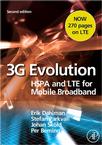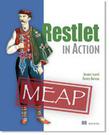Reflecting the recent completion of LTE's specification, the new edition of this bestseller has been fully updated to provide a complete picture of the LTE system. The latest LTE standards are included on the radio interface architecture, the physical layer, access procedures, MBMS, together with three brand new chapters on LTE Transmission Procedures, Flexible Bandwidth in LTE...
Reflecting the recent completion of LTE's specification, the new edition of this bestseller has been fully updated to provide a complete picture of the LTE system. The latest LTE standards are included on the radio interface architecture, the physical layer, access procedures, MBMS, together with three brand new chapters on LTE Transmission Procedures, Flexible Bandwidth in LTE and LTE evolution into IMT-Advanced. Key technologies presented include multi-carrier transmission, advanced single-carrier transmission, advanced receivers, OFDM, MIMO and adaptive antenna solutions, advanced radio resource management and protocols, and different radio network architectures. Their role and use in the context of mobile broadband access in general is explained. Both a high-level overview and more detailed step-by-step explanations of HSPA and LTE implementation are given. An overview of other related systems such as TD SCDMA, CDMA2000, and WiMAX is also provided. The new edition has up-to-date coverage of the recently published LTE Release 8 radio-access standard, giving the reader insight into the ongoing and future process of LTE and LTE-Advanced standardisation. Coverage on LTE in this edition includes ( total of 270 pages on LTE): Easy-to-access overview of the LTE protocol layers Complete description of LTE physical layer including reference signals, control signalling, multi-antenna transmission schemes Covers both FDD and TDD, their fundamental difference and their impact on the LTE design Detailed description of access procedures including cell search, random access, broadcast of system information Transmission procedures, including retransmission protocols, scheduling, uplink power control Evolution towards IMT-Advanced ("4G") "Reading a specification requires some effort. After reading the spec, you would know WHAT to transmit, but not WHY and HOW. This is where our book becomes important. Not only does it provide an easy-to-read description of the signals, procedures, and mechanisms in LTE, it also tells you WHY a certain signal, channel or procedure is present and HOW it is used. After reading the book, you will have a good understanding on how LTE works and why it is designed the way it is." - the authors The authors of the book all work at Ericsson Research and are deeply involved in 3G development and standardisation since the early days of 3G research. They are leading experts in the field and are today still actively contributing to the standardisation of both HSPA and LTE within 3GPP. This includes details of the standards and technologies (160 new pages): LTE radio interface architecture, LTE physical layer and LTE access procedures.
Includes details of the standards and technologies (160 new pages): LTE radio interface architecture, LTE physical layer and LTE access procedures
Contains three brand new chapters on LTE: Transmission Procedures, Flexible Bandwidth and LTE Evolution and expanded details on the physical layer (total LTE content is 270 pages)
Examines the latest developments in the evolution of LTE into IMT-Advanced, the next stage of 3G Evolution
Gives clear explanations of the role of OFDM and MIMO technologies in HSPA and LTE
Outlines the System Architecture Evolution (SAE) supporting LTE and HSPA evolution
 3G Evolution, Second Editiontxt,chm,pdf,epub,mobi下载
3G Evolution, Second Editiontxt,chm,pdf,epub,mobi下载 首页
首页



初中生最应该看的
新书,看看后追评
超赞
翻译得也很棒